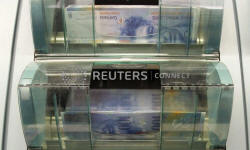Swiss franc races to two-year highs vs euro as trade
concerns rise
 Send a link to a friend
Send a link to a friend
 [June 03, 2019]
By Saikat Chatterjee [June 03, 2019]
By Saikat Chatterjee
LONDON (Reuters) - The Swiss franc
rallied to its highest levels in nearly two years against the euro on
Monday as U.S. President Donald Trump hardened his trade stance to
countries beyond China, prompting investors to move into perceived
safe-haven currencies.
Trade tensions have grabbed center stage for investors in recent weeks
after Trump increased tariffs on Chinese imports, threatened to raise
tariffs on Mexican imports and removed preferential trade treatment for
India.
Rising strains on trade have prompted investors to dump risky assets
such as equities and flock to low-yielding currencies such as the yen
and the franc with the latter flirting close to levels where the Swiss
National Bank has traditionally intervened to keep the currency weak.

"While the Swiss franc has appreciated strongly in recent weeks, much of
that gains is due to the wave of risk aversion sweeping across markets
and we need to see further substantial gains before the central bank has
to step in," said Manuel Oliveri, a currency strategist at Credit
Agricole in London.
Against the euro, the franc rallied more than half a percent to 1.1120
francs per euro, its highest level since July 2017, before trimming some
gains to stand 0.2% up on the day.
Monday's gains come on top of a strong surge in May when the franc
gained more than 2% versus the euro, its biggest monthly rise in eight
months as trade tensions fueled a global selloff in risky assets.
The Swiss National Bank, which pursues a monetary policy of negative
interest rates and currency intervention, has traditionally intervened
when the franc has risen to around 1.10 francs per euro but low
inflation and trade tensions suggest the franc has to gain far more from
current levels.
Latest data indicate price pressures remain well contained with consumer
prices rising 0.6 percent in May from a year-ago period.
[to top of second column] |

Japanese 10,000 yen notes line up in Tokyo, in this February 28,
2013 picture illustration. REUTERS/Shohei Miyano/File Photo

The franc wasn't the only low-yielding currency to shine, with the Japanese yen
also broadly gaining against a swathe of currencies.
EURO VULNERABLE
The euro was slightly firmer on the day at $1.1185 but investors remained
broadly cautious on the outlook of the single currency as manufacturing data in
the eurozone contracted for a fourth month in July.
The weak data comes in a busy week for European Central Bank policymakers as
officials may announce details of a new round of cheap multi-year loans for
banks.
Meanwhile, expectations of a rate cut have also grown in money markets with
futures pricing in a 50% chance of a rate cut before the end of the year.
"With a dovish ECB expected, it is challenging to envision strong gains now for
the euro," said Marc Chandler, chief market strategist at Bannockburn Global
Forex.
A senior Chinese official and trade negotiator said on Sunday Washington cannot
use pressure to force a trade deal on China and refused to be drawn on whether
the leaders of the two countries would meet at the G20 summit in Japan at the
end of the month to bash out an agreement.
The dollar dipped after benchmark 10-year U.S. Treasury yields hit as low as
2.121% on Monday, their lowest since September 2017.

Against a basket of six major currencies, the dollar was slightly negative at
97.71, though it is still up 1.6% for the year.
(Reporting by Saikat Chatterjee; Editing by William Maclean)
[© 2019 Thomson Reuters. All rights
reserved.] Copyright 2019 Reuters. All rights reserved. This material may not be published,
broadcast, rewritten or redistributed.
Thompson Reuters is solely responsible for this content. |